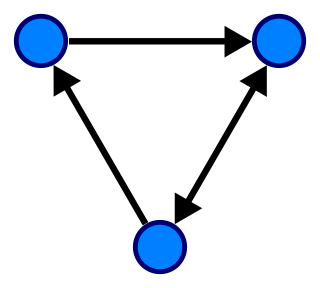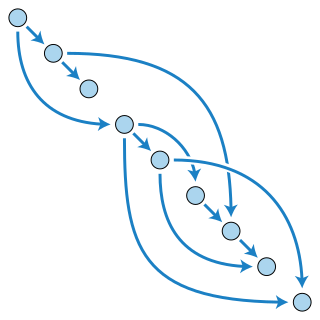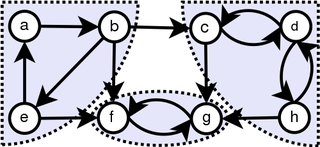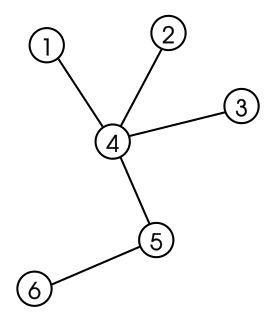
In graph theory, a tree is an undirected graph in which any two vertices are connected by exactly one path, or equivalently a connected acyclic undirected graph. A forest is an undirected graph in which any two vertices are connected by at most one path, or equivalently an acyclic undirected graph, or equivalently a disjoint union of trees.

In mathematics, a hypergraph is a generalization of a graph in which an edge can join any number of vertices. Formally, a hypergraph is a pair where is a set of elements called nodes or vertices, and is a set of non-empty subsets of called hyperedges or edges. Therefore, is a subset of , where is the power set of . The size of vertex set is called the order of the hypergraph, and the size of edges set is the size of the hypergraph.
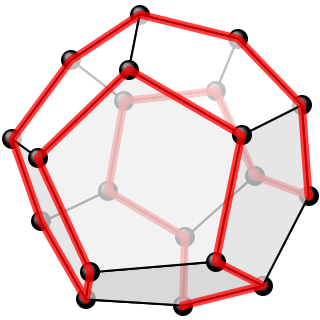
In the mathematical field of graph theory, a Hamiltonian path is a path in an undirected or directed graph that visits each vertex exactly once. A Hamiltonian cycle is a Hamiltonian path that is a cycle. Determining whether such paths and cycles exist in graphs is the Hamiltonian path problem, which is NP-complete.
This is a glossary of graph theory terms. Graph theory is the study of graphs, systems of nodes or vertices connected in pairs by edges.

In mathematics, and more specifically in graph theory, a graph is a structure amounting to a set of objects in which some pairs of the objects are in some sense "related". The objects correspond to mathematical abstractions called vertices and each of the related pairs of vertices is called an edge. Typically, a graph is depicted in diagrammatic form as a set of dots or circles for the vertices, joined by lines or curves for the edges. Graphs are one of the objects of study in discrete mathematics.
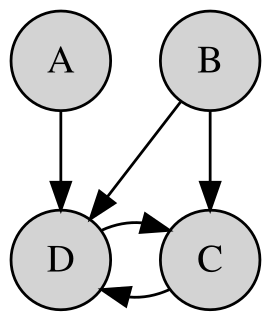
A graphical model or probabilistic graphical model (PGM) or structured probabilistic model is a probabilistic model for which a graph expresses the conditional dependence structure between random variables. They are commonly used in probability theory, statistics—particularly Bayesian statistics—and machine learning.

In graph theory, a cycle graph or circular graph is a graph that consists of a single cycle, or in other words, some number of vertices connected in a closed chain. The cycle graph with n vertices is called Cn. The number of vertices in Cn equals the number of edges, and every vertex has degree 2; that is, every vertex has exactly two edges incident with it.
In graph theory, reachability refers to the ability to get from one vertex to another within a graph. A vertex can reach a vertex if there exists a sequence of adjacent vertices which starts with and ends with .
In computational complexity theory, generalized geography is a well-known PSPACE-complete problem.
In mathematics, a transitive reduction of a directed graph D is another directed graph with the same vertices and as few edges as possible, such that if there is a (directed) path from vertex v to vertex w in D, then there is also such a path in the reduction. Transitive reductions were introduced by Aho, Garey & Ullman (1972), who provided tight bounds on the computational complexity of constructing them.

In graph theory, an edge contraction is an operation which removes an edge from a graph while simultaneously merging the two vertices that it previously joined. Edge contraction is a fundamental operation in the theory of graph minors. Vertex identification is a less restrictive form of this operation.

A parity game is played on a colored directed graph, where each node has been colored by a priority – one of (usually) finitely many natural numbers. Two players, 0 and 1, move a token along the edges of the graph. The owner of the node that the token falls on selects the successor node, resulting in a path, called the play.
In mathematics and computer science, a pebble game is a type of mathematical game played by moving "pebbles" or "markers" on a directed graph. A variety of different pebble games exist. A general definition of pebbling is given below.
In graph theory, the cycle rank of a directed graph is a digraph connectivity measure proposed first by Eggan and Büchi. Intuitively, this concept measures how close a digraph is to a directed acyclic graph (DAG), in the sense that a DAG has cycle rank zero, while a complete digraph of order n with a self-loop at each vertex has cycle rank n. The cycle rank of a directed graph is closely related to the tree-depth of an undirected graph and to the star height of a regular language. It has also found use in sparse matrix computations and logic (Rossman 2008).
In graph theory, the tree-depth of a connected undirected graph G is a numerical invariant of G, the minimum height of a Trémaux tree for a supergraph of G. This invariant and its close relatives have gone under many different names in the literature, including vertex ranking number, ordered chromatic number, and minimum elimination tree height; it is also closely related to the cycle rank of directed graphs and the star height of regular languages. Intuitively, where the treewidth graph width parameter measures how far a graph is from being a tree, this parameter measures how far a graph is from being a star.
In graph theory, a cop-win graph is an undirected graph on which the pursuer (cop) can always win a pursuit-evasion game in which he chases a robber, the players alternately moving along an edge of a graph or staying put, until the cop lands on the robber's vertex. Finite cop-win graphs are also called dismantlable graphs or constructible graphs, because they can be dismantled by repeatedly removing a dominated vertex or constructed by repeatedly adding such a vertex. The cop-win graphs can be recognized in polynomial time by a greedy algorithm that constructs a dismantling order. They include the chordal graphs, and the graphs that contain a universal vertex.
In graph theory, a branch of mathematics, the cop number or copnumber of an undirected graph is the number of cops to win a certain pursuit-evasion game on the graph.

